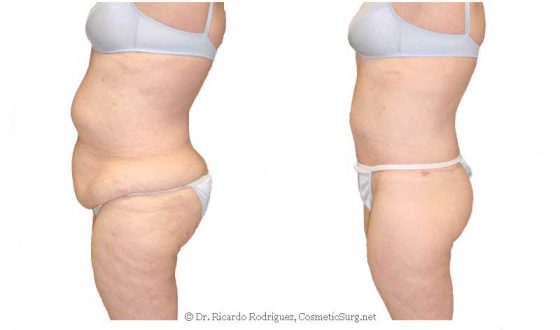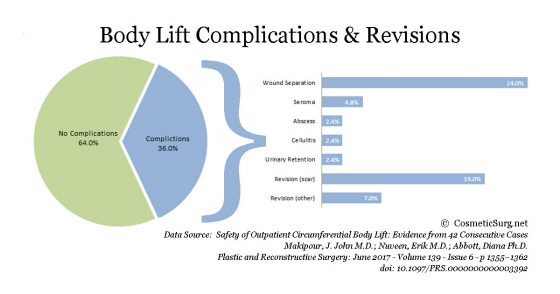
The Lower body lift procedure removes excess skin from the entire lower part of the body (stomach, hips and buttocks) and it is an ideal choice for patients who have experienced massive weight loss. However, even patients who have not had WLS are candidates for the body lift procedure. If you have loose hanging skin around your entire midsection, you are likely a candidate for this procedure.
As with any surgery, the body lift comes with possible complications and potential revisions as it lifts and tightens the entire lower part of the body. The good news is that most complications are relatively minor. Most revisions are simply touch ups and can be handled post operatively in the office setting.
Types of Body Lift Complications
In general, possible complications from the Body Lift procedure include:
fluid accumulation, hematoma, seroma, infection, poor wound healing (wound separation), asymmetry, unfavorable scarring, numbness or other changes in skin sensation, fat necrosis and deep vein thrombosis (primarily associated with General Anesthesia).
Body lift complication percentages & revision rates
36% of all patients who undergo a Body lift procedure will have a complication
-Ricardo L Rodriguez, MD
The Body lift is a major procedure and as with any surgery, there are potential complications that should be discussed with your board certified plastic surgeon during your consult.
A recent study analyzing 42 consecutive outpatient lower body lift procedures determined that 36% of all patients who undergo a Body lift procedure will have a minor complication and that 1 in 4 patients will have wound separation during the post-op period (which can be addressed in the office or clinic).

The revision rate among the 42 patients was determined to be 26% with the majority of revisions to improve the appearance of the scar. In this study, there were no deaths, venous thromboembolic events, hematomas, transfusions, or hospitalizations among the 42 lower body lift patients studied.
Avoiding Body lift complications
Good surgical technique achieves the *best* results with the least amount of post-operative complications.
-Dr. Rodriguez
Pre-op evaluation and BMI criteria for Body Lift Procedure
It is obviously the goal of every good surgeon and patient to avoid complications. One of the major risks is BMI, or Body Mass Index. Your BMI should be 35 or less. In addition, you need to have a medical clearance within 30 days of your surgery date.
Technique of the surgeon can influence the complication rate
For example, it is my experience that wound closure and fluid collection complications tend to occur if too much fat is removed from the subcutaneous layers. I find the Lockwood technique results in more secure skin closure and helps me to achieve the thinnest possible scar. With this technique, the suture tightening is applied to the deeper layers and prevents the scar at the top layer from widening over time.
General Anesthesia carries a higher risk of DVT compared to IV propofol sedation
Additionally, for a long surgery like the body lift, IV anesthesia administered by a board certified anesthesiologist is a much safer choice than general anesthesia. I have written about reducing risk during body lifts in the past, see this blog post. Just be certain to learn everything you can about the procedure and ask a lot of questions about surgical technique (and why) during your consultation.
Learn more about Body lifts
If you have experienced weight loss following a bariatric procedure, diet, and exercise learn more about the Body lift procedure and start consulting with board-certified plastic surgeons to discuss how this procedure might help you complete your transformation. This is a fantastic procedure that yields dramatic results!




fourseasonslasercenter says:
Dr. Ricardo L. Rodriguez says: